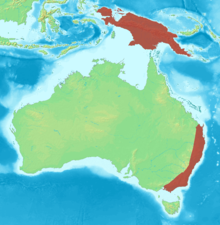Kingdom : Animalia
Phylum : Chordata
Class : Aves
Order : Strigiformes
Family : Tytonidae
Genus : Tyto
Species : T. tenebricosa
Known also as Black Owls or Dusky Barn Owls, these birds are rarely seen or heard. A medium large, sooty black Owl with very large, dark eyes set in a round facial disc. The upperparts are sooty black, finely spotted white on the head with larger but sparser white spots on the wings. The Facial disc is large, round and sooty black through to dark grey or silver and is heavily edged black. The underparts vary from sooty black to dark grey, (never as dark as the upperparts) finely spotted with white. The Belly is always paler than the breast. The tail is very short, the legs feathered and eyes very large with a black iris. A Sooty Owl's Bill is horn coloured and feathered almost to the tip. Toes are dark grey and the large talons black. Sexes are similar in plumage and Females are usually slightly larger than males. They are distinguished from lesser Sooty Owls by much larger size and darker plumage, sparser white spots on upperparts and darker underparts which have white spots on a dark background where the lesser Sooty Owl has dark chevrons on a pale background.
Size: Female - Length 44-51 cm (17-20") Weight 750-1000g (26.5-35 oz)
Male - Length 37-43 cm (14.5-17") Weight 500-700g (17.5-24.5 oz)
Habits: Strictly Nocturnal. Hides during the daytime in crevices, hollow tree trunks, dense foliage of tall trees, and sometimes caves.
 Voice: The characteristic call is a piercing downscale shriek, lasting for upwards of two seconds. It has been likened to the sound of a falling bomb without the final explosion and the call is now widely known as the 'bomb whistle'. There are also various other calls associated with breeding and nesting.
Voice: The characteristic call is a piercing downscale shriek, lasting for upwards of two seconds. It has been likened to the sound of a falling bomb without the final explosion and the call is now widely known as the 'bomb whistle'. There are also various other calls associated with breeding and nesting.Hunting & Food: The Sooty Owls is a powerful hunter and takes some remarkably big prey, a high proportion being arboreal. This contrasts not only with the lesser Sooty but with all other Tyto Owls, which take most of their prey on the ground. The huge eyes of both sooty Owls compared with other Tyto Owls suggests a greater reliance on vision. Sugar Gliders and Ringtail Possums make up a high proportion of the prey but a wide variety of other mammals have been recorded. There are no records of hunting methods. The male does all the hunting during breeding and usually brings one large prey item per night.
Breeding: The season is variable, with most eggs laid from January through to June but there are some records of laying in spring (August-September). Males often become more noisy at the start of the season, giving frequent 'bomb whistles'. The male feeds the female in the hollow, engaging her with soft, high-pitched trilling before passing over the prey. The nest is usually in a large hollow in a living tree at any height from 10 to 50 metres (33-164 feet). There are a few records of nesting in caves. Females occupy the hollow for many weeks before laying, flying out only briefly during night. A female in a cave nest site rarely leaves at all. 1 or 2 dull white eggs are laid, measuring 44-52mm (1.7-2") by 36-41mm (1.4-1.6"). Incubation is around 42 days. The young are covered in sooty grey down and are fledged in about 3 months. The newly fledged Sooty Owl is dependent on its parents for up to a month.

Habitat: Deep moist gullies in eucalypt forest, usually with big, old, smooth-barked gums and an understorey of tree ferns and Lilly Pilly. They may move into drier forest to hunt but they need the primary habitat for roosting and breeding. They are Territorial and sedentary throughout the year.
Distribution: Coastal and mountain regions of south-eastern Australia from the Dandenong Ranges near Melbourne to the Conendale Range north of Brisbane. Reportedly present on Flinders Island in the Bass Strait. They are also found in the Montane rainforests of New Guinea.


 00.14
00.14
 fahmi adhoc
fahmi adhoc

0 comments:
Posting Komentar